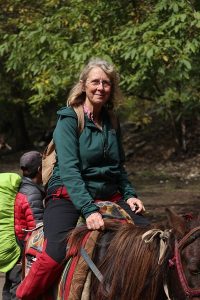Creating an Audiobook – In Kathmandu
 I am a fortunate woman. Our family and friends have mostly sidestepped the awful virus and I have managed to stay productive throughout lockdown whereas many of my writing friends have found it hard to focus. Perhaps living so many years as a nomadic expatriate has equipped me to face changes in circumstances?
I am a fortunate woman. Our family and friends have mostly sidestepped the awful virus and I have managed to stay productive throughout lockdown whereas many of my writing friends have found it hard to focus. Perhaps living so many years as a nomadic expatriate has equipped me to face changes in circumstances?
I have been privileged to find publishers for eight of my books but only one has my heart and soul in it. This is the memoir that centres on my troubled middle son, David. His book (as I think of it) has appeared in four continents with three publishers and for years I have had it in mind to record it as an audiobook. Working with writing groups told me that reading a thousand words out loud takes less than ten minutes, so reading the entire 130,000-word book would only take a couple of weeks – surely?
I discovered that most authors use a programme called Audacity. I was in Kathmandu and initially assumed I would rent studio time but discovered that the technology is so good that, with a decent microphone, an acceptable recording can be achieved in an ordinary room.
I remember writing simple computer programmes then feeding them into enormous machines through tickertape and punch cards but I am technically incompetent. When I started recording with Audacity, words used to describe aspects of the programme were not only unknown to me but they were indecipherable. There are, fortunately, oodles of helpful ‘how to’ clips on YouTube but even so, the tech was bewildering and gave me a headache.
 I asked my techy son for help and, although he was brilliantly supportive, he told me I’d need to slog through on-line tutorials myself. This was what he’d have to do, after all. Slowly, I learned to use relevant parts of the programme and began recording chapter by chapter. I thought background sounds of Kathmandu would be interesting so I tried recording outside.
I asked my techy son for help and, although he was brilliantly supportive, he told me I’d need to slog through on-line tutorials myself. This was what he’d have to do, after all. Slowly, I learned to use relevant parts of the programme and began recording chapter by chapter. I thought background sounds of Kathmandu would be interesting so I tried recording outside.
This was not a good idea. Inside I softened sounds in one rather echoey room by bringing in duvets and towels. I knew I wasn’t great at reading aloud but I was astonished at how difficult it was to read coherently and with feeling. I thought I was quite good at accents – I discovered I’m not. I stumbled over familiar words, I got the giggles, my stomach rumbled or I got hiccups. A plane would fly over or a child shriek or a motorbike horn-honk. I needed to do a lot of re-recording and editing.
I learned that it is easier to follow dialogue as words on a page, but in an audio, the listener needs more signposting to who is speaking, and although it is possible to cut and paste a ‘he said’ from the end of a sentence to the beginning, the intonation is all wrong. I had to resist the temptation to edit the original text too.
When I originally wrote my memoir I experienced real physical heartache when I recalled the toughest parts of little David’s illnesses. Recording the audiobook meant returning to that tough stuff again, although that meant listeners could really hear the emotion. Certainly, my voice was breaking as I read some passages.
After about five months’ work, I’d recorded and edited all 35 chapters. I had also recorded local bird songs to begin and end each chapter with. I started uploading my files to Amazon’s Audible site. This has various automatic responses and initially the bounce-back responses told me that things were wrong with most of the chapters.
 Mostly I didn’t understand how I was wrong though. The language again was unintelligible. I was so dispirited by this that I did nothing for several weeks. Then I returned to various YouTube tutorials. My knowledge improved. More of my chapters got through the initial Audible quality control bots (or whatever they are called). Some didn’t. I studied more. I hit stumbling blocks again and again.
Mostly I didn’t understand how I was wrong though. The language again was unintelligible. I was so dispirited by this that I did nothing for several weeks. Then I returned to various YouTube tutorials. My knowledge improved. More of my chapters got through the initial Audible quality control bots (or whatever they are called). Some didn’t. I studied more. I hit stumbling blocks again and again.
At one point I was so fed up by this mire of computer and audio gobbledegook that I gave up. But only for a while. After another couple of months, I managed to upload all my chapters.
I had to wait ‘up to 30 days’ for feedback from real people about the quality of the recording. My audiofiles didn’t pass. I made revisions. They failed again. I made revisions. I discovered that ‘up to 30 days’ usually meant 29 working days, or more like six weeks.
Just before Christmas, I received a message saying CONGRATULATIONS. The book was live.
It had been an enormous labour, but it was a labour of love and, being a techno dinosaur I feel especially proud to have succeeded, finally.
- It took me a full day and a half to record and edit one chapter
- Even the best actors stumble when reading aloud and it is best to carry on reading and edit the whole chapter once you’ve reached the end
- It is worth investing in a good microphone
- Your ‘studio’ needs to be well set up with plenty of soft stuff in the room to absorb echoes
- Recording and uploading my book took about nine months, for much of that time I was working on the project full time.
- On the face of it, Audible charge a lot of money for audiobooks but I realise that this reflects the amount of time involved in producing them. It is though possible to download your first audiobook as a free trial when signing up for a (cancellable) subscription.
—
 Jane Wilson-Howarth has published three travel health guides, two travel narratives, a novel for adults and two wildlife-packed adventure stories for middle grade readers. Her fiction is all set in Nepal where she is currently living, and has lived for around nine years.
Jane Wilson-Howarth has published three travel health guides, two travel narratives, a novel for adults and two wildlife-packed adventure stories for middle grade readers. Her fiction is all set in Nepal where she is currently living, and has lived for around nine years.
She is a physician also trained in zoology and divides her time between Kathmandu and Cambridgeshire. During the early part of this year she was in the UK as a volunteer COVID vaccinator. Now she is back enjoying her favourite Himalayan view and is helping design radio programmes to be broadcast in Nepal to counter misinformation about COVID-19 and the vaccines. When not writing, she will be seen out on her bicycle or with binoculars scanning for birds or other wildlife.
Website: https://www.wilson-howarth.com
Goodreads: https://www.goodreads.com/author/show/259432.Jane_Wilson_Howarth
Instagram: https://www.instagram.com/longdropdoc/
Facebook: https://www.facebook.com/search/top?q=jane%20wilson-howarth%20author
Twitter: https://twitter.com/longdropdoc
A Glimpse of Eternal Snows
A Journey of Love and Loss in the Himalayas (Bradt Travel Guides )
 In pulsating polluted Kathmandu, and an idyllic village at the foot of the Himalayas, “Doctor Jane” and her engineer husband, Simon, hope to make a difference: Jane to fulfill her vision to heal and advocate for the poor, Simon to avert floods that threaten to devastate the country every monsoon. As they acclimatize and begin to absorb something of an accepting Nepali view of life, they find sanity, compassion, and joy with baby David, who in England was little more than an interesting medical case.
In pulsating polluted Kathmandu, and an idyllic village at the foot of the Himalayas, “Doctor Jane” and her engineer husband, Simon, hope to make a difference: Jane to fulfill her vision to heal and advocate for the poor, Simon to avert floods that threaten to devastate the country every monsoon. As they acclimatize and begin to absorb something of an accepting Nepali view of life, they find sanity, compassion, and joy with baby David, who in England was little more than an interesting medical case.
This is a tale of Himalayan highs and lows, of cultural complexities, unexpected wildlife, and rugged terrain, of vivid color, superstition, and spicy smells. A moving candid story of courage, love, and a family’s determination to give their children the best life possible.
“The proverbial life-changing book.” (The Daily Telegraph)
You can find the book here
Category: Contemporary Women Writers, How To and Tips
























Thanks so much Jena, I’m delighted you found it helpful, and putting your book out as a podcast would be like returning to writers of the Victorian era Conan Doyle and Dickens who first published in magazines. Maybe the feedback would be useful too!!
You post is extremely helpful. You should write a book about this (and then record it, ha!) congrats on your accomplishment. I was thinking of doing a chapter by chapter podcast of my first book.